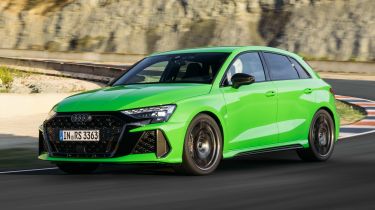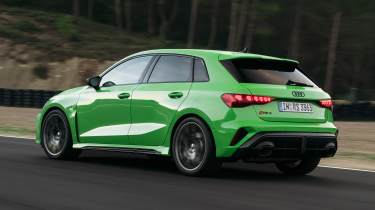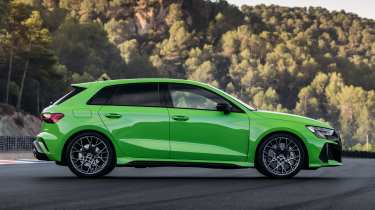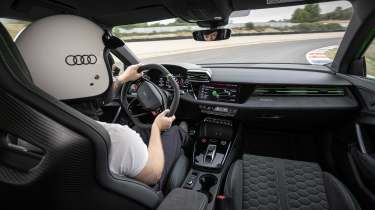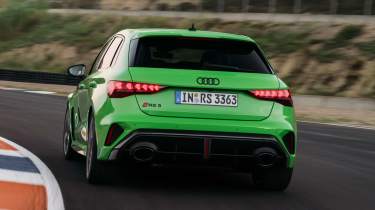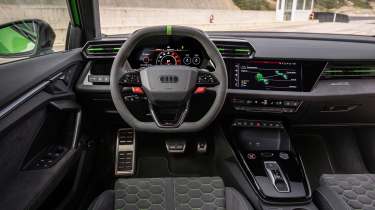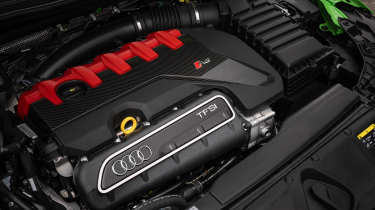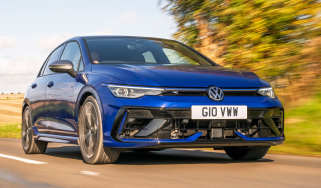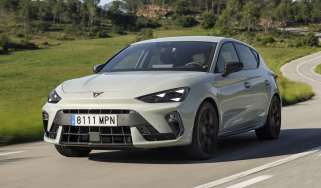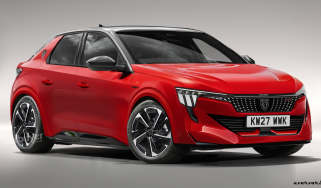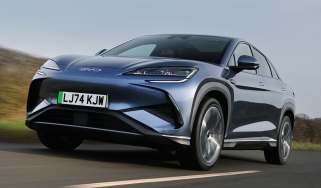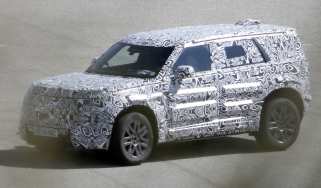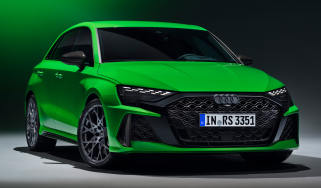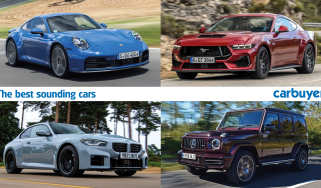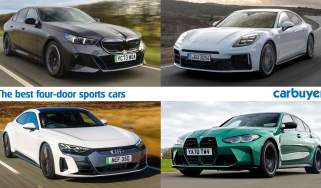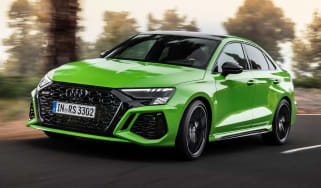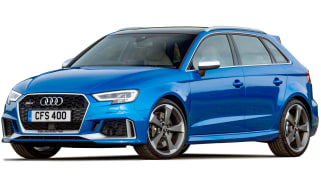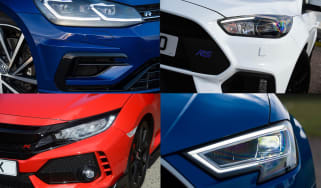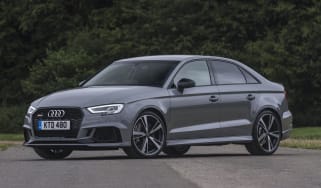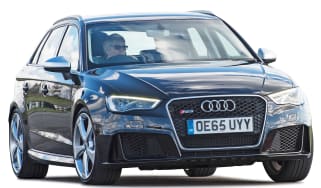Audi RS 3 review – better to drive than ever
“The Audi RS 3 is fearsomely quick but can be just as easy to drive as the regular A3”
Pros
- Engine sound
- Quickest hot hatchback
- As comfortable as regular A3
Cons
- Expensive
- Running costs
- Average warranty
Verdict – is the Audi RS 3 a good car?
The Audi RS 3 has always had the most exciting engine of the latest crop of hot hatchbacks, but it hasn’t always been the most engaging steer. However, a major rethink of its chassis for this generation – with further tweaks for its latest facelift – have really sharpened things up. It’s now the hyper hatch to beat.
Audi RS 3 models, specs and alternatives
The Audi RS 3 Sportback has been amongst the UK’s fastest-accelerating, most exciting – and most expensive – hot hatchbacks since it first arrived. It has put the RS 3, which is the sportiest version of the Audi A3, in a fierce fight with the Mercedes-AMG A45 S for hot-hatch supremacy. With nearly 400bhp, it’s in a different league to cars like the Ford Focus ST and Hyundai i30 N;, both in terms of performance and price. In fact, its latest threat is from a new breed of electric performance cars like the Hyundai Ioniq 5 N.
You can also choose to have your RS 3 as a four-door saloon which, to our eyes, looks even better than the hatchback. Perhaps because it’s reminiscent of other fast saloons like the BMW M3 and Mercedes-AMG C63, it feels a little more exotic than the Sportback. It’s less practical and £1,000 more expensive than the hatchback but will undoubtedly appeal to many RS 3 buyers. Its main rival is the Mercedes-AMG CLA 45 S.
 The UK's top 10 fastest hot hatchbacks 2025
The UK's top 10 fastest hot hatchbacks 2025
Facelifted in 2024, the RS 3 gained mostly cosmetic changes, with an even wider grille flanked by gulping air intakes. There’s also a new front bumper and a set of LED headlights with 24 individual elements that can be tweaked to the owner’s preferred pattern. The rear bumper diffuser also gets a motorsport-inspired look, and there are new colour options and wheel designs.
More reviews
The RS 3 uses a turbocharged, 2.5-litre five-cylinder petrol engine, which produces a distinctive and exciting sound that helps the RS 3 stand out against rivals – especially those that recharge instead of refuel. For many buyers, it’s the reason to choose an RS 3 over the A45, while the BMW M2 is similarly tuneful thanks to a 3.0-litre six-cylinder engine. Whereas the Audi S3’s 2.0-litre engine is used in nearly every VW Group performance car, the 2.5-litre is relatively rare; only the discontinued Audi TT RS and Cupra Formentor VZ5 used it too.
The car is much better in corners than its predecessor, while Audi’s quattro all-wheel-drive system means its performance is accessible even in the most British of weather conditions. On a twisting B-road it is nothing short of phenomenal, and numerous settings let you tailor the experience.
In fact, the RS 3 might be one of Audi’s best cars right now. It’s certainly more exciting than the bigger Audi RS 5, despite that car coming with more power, a bigger engine and a chunkier price. The RS 3 brings pace that you’d have only experienced in a supercar a few years ago, and the Carbon Vorsprung trim has some highlights that include a raised 174mph top speed figure.
Inside, the RS 3 builds on the A3’s excellent interior with lots of sporty touches, including bucket seats trimmed in very high quality leather and specific graphics for the infotainment system. It’s an expensive car, coming in at more than double the price of the cheapest Audi A3, but you’re unlikely to feel shortchanged given the performance. Although the interior is brilliantly high-tech, we wonder if it should feel more different from a base-model A3.
On both Sportback and Saloon models, there are three trim levels to choose from. Above the standard RS 3 are Carbon Black and Carbon Vorsprung editions, each with black exterior trim instead of silver, plus extra equipment. The Carbon Black version now adds a large roof spoiler, too.
MPG, running costs & CO2
Given the amount of power it has, the Audi RS 3 is unsurprisingly expensive. Not only to buy – it starts at just under £60,000 and top-spec cars are considerably more – but it’ll cost a fair amount to fuel, tax, insure and maintain. Its 30.4mpg best-case figure isn’t too bad but that’ll quickly tumble when you put your foot down. Because it comfortably exceeds £40,000, the RS 3 is subject to an annual VED (road tax) bill of around £600 in the first five renewal years; after that, it drops to the standard annual rate applied to all non-hybrid petrol and diesel cars.
The pre-facelift RS 3 sat in group 35 for insurance (out of 50), while top-spec Vorsprung occupied group 40, for both the hatchback or saloon. That’s roughly on a par with the group 41 Mercedes-AMG A 45, and with both cars it’s important to make sure you get a quote before deciding to buy – it’s likely to be a significant cost. The RS 3 will cost more to service than a standard A3, due to its upgraded chassis, larger brakes and highly tuned engine, while it’ll eat up consumables like high-performance tyres at a quicker rate than a lesser model. Choose the (expensive) optional ceramic brakes and you can expect another big bill when it’s time to replace them.
The RS 3 gets a fairly average three-year/60,000-mile warranty, whereas the Mercedes at least gets unlimited mileage over the same period. You can upgrade your warranty cover to four years/75,000 miles or five years/ 90,000 miles for around £500 and £1,000 respectively.
Engines, drive & performance
The RS 3 has the same five-cylinder 2.5-litre turbocharged petrol engine as the previous model with the same 395bhp output. However, power for this generation of RS 3 is available lower down the rev range, so acceleration has improved. Taking just 3.8 seconds to get from 0-62mph, the new RS 3 is a tenth of a second quicker than the 415bhp Mercedes-AMG A45 S and is now the quickest hot hatch on the market. While it used to be an optional extra to remove the speed limiter, enabling the car to reach a top speed of 174mph, it’s now standard for the Carbon Vorsprung trim.
The RS 3 has always been rapid in a straight line, and its engine’s character has been a big part of its appeal, but it has previously failed to really excite in corners. A new suspension system was fitted for this generation to improve that aspect of the car, most of which is specific to the RS 3, and the car sits 10mm lower than even the Audi S3.
Audi has fitted something it calls a ‘Torque Splitter’, which can juggle power between individual wheels. For example, if you start to push wide in a corner, power will be sent to the outside wheels to bring you back into line, while the system can also deal with a slipping wheel to maintain grip on the road. Up the pace, and it can feel a little unusual at first, but learn to trust the car and you’ll be able to drive more quickly through corners than almost any other car.
It has been further improved for the 2024 facelift, slashing five seconds from the car’s Nurburgring Nordschleife lap time (with Audi racing driver Frank Stippler behind the wheel) without any increases in power. The car’s systems now talk to each other more quickly, making the chassis even more resistant to understeer where the nose washes wide of the apex.
 The 10 best hot hatchbacks to buy in 2025
The 10 best hot hatchbacks to buy in 2025
If the mood takes you, the system also has an ‘RS Torque Rear’ setting, otherwise known as a drift mode, allowing the RS 3 to go sideways in a flamboyant fashion if you happen to have access to a private facility.
The suspension in some hot hatchbacks, like the Ford Focus ST and Honda Civic Type R, never really settles down, so the cars can become tiring to be in on long journeys. The RS 3, meanwhile, is just as composed and as easy to drive as a regular A3 when you put everything in Comfort mode. The exhaust note also becomes quieter in this setting. Flick back into Sport and the car makes a much angrier and more exciting noise.
Interior & comfort
Slide into the RS 3 and you’re greeted by sportier seats than those in the regular A3s, plus red air vents, stitching and ambient lighting. There’s also a new steering wheel for the facelift, with a flat top and bottom, along with touch-sensitive controls. It’s a shame these are prone to being activated accidentally, so it’s a backwards step in our eyes. Save for those changes and the RS driving modes, the interior is shared with the rest of the A3 range. We like the A3’s interior, with its quality materials, high-tech feel and stepped layout, the latter of which happily includes a mix of digital and physical controls.
There are three main trim levels to pick from: RS 3, Carbon Black and Carbon Vorsprung. As you’d hope, the basic RS 3 still gets plenty of equipment, including 19-inch wheels, LED headlights, three-zone climate control, Nappa sports seats and Audi’s Virtual Cockpit. A head-up display, Sonos premium stereo and reversing camera are also standard.
Carbon Black adds a set of 19-inch cross-spoke alloy wheels, darkened Matrix LED headlights and dynamic rear indicators and a gloss black exterior trim makeover. Carbon Vorsprung ushers in adaptive suspension, a panoramic roof, electric front seats with memory and extra driver assistance tech.
Options include a Technology Pack Pro for the standard trim, that brings Matrix LED headlights and LED rear clusters, a panoramic roof, electrically adjustable front seats and extra driving aids for just over £3,000 – not bad value.
Practicality & boot space
There’s no three-door RS 3 for this generation, so both the hatchback and saloon make it easy for adults or children to get in the back seats. The RS 3 is wider and longer than the standard A3 but the differences are only in the bodywork. Luckily, both headroom and legroom are generous in the outer rear seats but, as with many cars this size, the middle seat isn’t so comfortable.
The standard Audi A3 Sportback and A3 Saloon offer 380 and 425 litres of boot space respectively but the RS 3’s mechanicals cut approximately 100 litres off both of those figures. The hatchback’s load space is poor at 282 litres; the saloon offers 321. While the saloon’s boot is a little bigger, the hatchback’s tailgate opening means it’s much easier to load large items.
Reliability & safety
The Audi A3 finished in 59th place out of the top 75 cars ranked in our Driver Power owner satisfaction survey in 2022, but hasn’t appeared in the years since. Audi finished in a meagre 27th place out of 32 brands ranked. Some 21.3% of owners reported a fault with their car in the first year of ownership. The amount of RS-exclusive parts in the suspension means we don’t know how reliable this aspect of the car will be, but most other parts are shared with the A3 and other models in the VW Group.
A3 owners who ranked the car in 2022 complained about the smartphone connectivity, interior styling and the infotainment system, but noted that interior quality was impressive. Practicality and engines were also praised, although the A3’s ride and handling was given a poor mark.
The RS 3 hasn’t been safety tested specifically but it shares the A3’s five-star Euro NCAP score. When tested in 2020, the A3 scored 89% for adult occupant protection and 81% for child protection, so there should be no concerns here.
Standard safety equipment includes hill-hold assist (to prevent the car rolling backwards when starting up from an incline), autonomous emergency braking, pedestrian and cyclist detection, lane-departure warning (at speeds above 37mph) and collision avoidance. Top-spec models also get traffic sign recognition, a 360-degree camera, a head-up display and semi-autonomous driving capability.
Which Is Best?
Cheapest
- NameRS 3 TFSI Quattro 5dr S Tronic
- Gearbox typeSemi-auto
- RRP£60,195
Most Economical
- NameRS 3 TFSI Quattro 5dr S Tronic
- Gearbox typeSemi-auto
- RRP£60,195
Fastest
- NameRS 3 TFSI Quattro 5dr S Tronic
- Gearbox typeSemi-auto
- RRP£60,195
